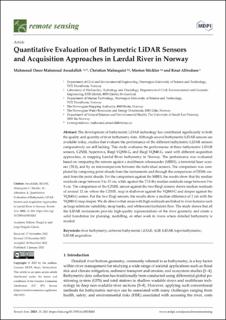| dc.description.abstract | The development of bathymetric LiDAR technology has contributed significantly to both the quality and quantity of river bathymetry data. Although several bathymetric LiDAR sensors are available today, studies that evaluate the performance of the different bathymetric LiDAR sensors comparatively are still lacking. This study evaluates the performance of three bathymetric LiDAR sensors, CZMIL Supernova, Riegl VQ880-G, and Riegl VQ840-G, used with different acquisition approaches, in mapping Lærdal River bathymetry in Norway. The performance was evaluated based on comparing the sensors against a multibeam echosounder (MBES), a terrestrial laser scanner (TLS), and by an intercomparison between the individual sensors. The comparison was completed by comparing point clouds from the instruments and through the comparison of DEMs created from the point clouds. For the comparison against the MBES, the results show that the median residuals range between 3 to 13 cm, while against the TLS the median residuals range between 0 to 5 cm. The comparison of the CZMIL sensor against the two Riegl sensors shows median residuals of around 12 cm where the CZMIL map is shallower against the VQ880-G and deeper against the VQ840-G sensor. For the two Riegl sensors, the results show a median difference of 2 cm with the VQ880-G map deeper. We do observe that areas with high residuals are linked to river features such as large substrate variability, steep banks, and whitewater/turbulent flow. The study shows that all the LiDAR instruments provide high-quality representations of the river geometry and create a solid foundation for planning, modelling, or other work in rivers where detailed bathymetry is needed. | en_US |

